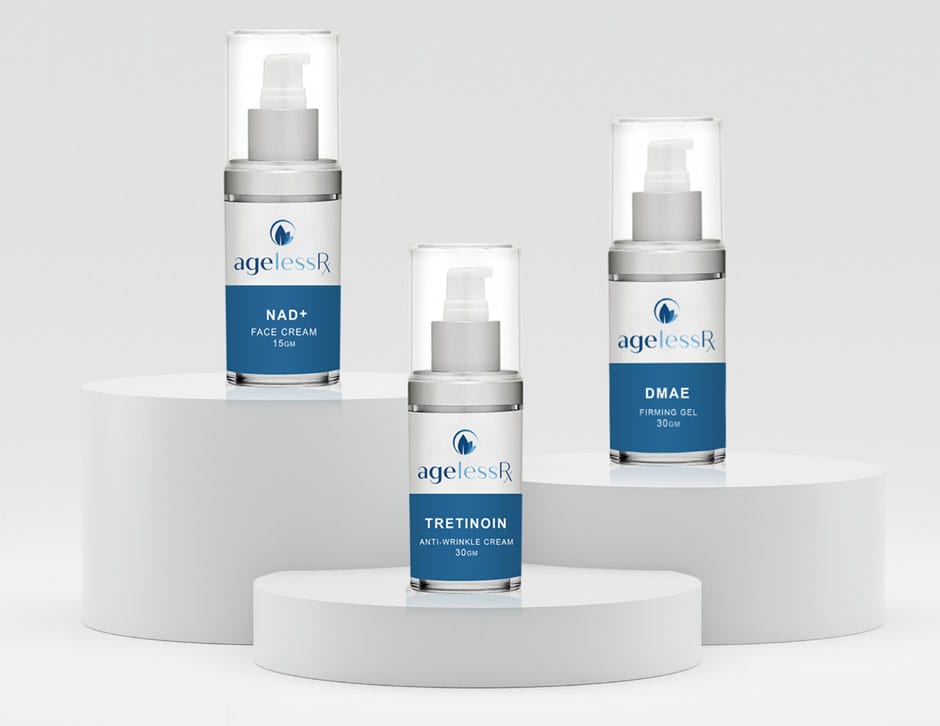
Whether you’re just starting out with Tretinoin or DMAE, or you’re considering an upgrade to your current routine, we’ve got the scoop on all things you need to know to make the most of your treatment.
Our team recently sat down with AgelessRx Chief Medical Officer, Dr. Sajad Zalzala, and our partnering pharmacist at Innovation Compounding, Tara Thompson, to tackle your most frequently asked questions about the products in our skin care suite. Here’s what we learned:
- How do I know Tretinoin Anti-Wrinkle Cream is working?
Early signs of Tretinoin at work are mild. Symptoms can include tingling, burning, or, in some cases, mild peeling during or following application. Many patients express a “it gets worse before it gets better” sentiment during this time. This is due to your skin turning over new layers, resulting in brighter and tighter skin. Most patients see early results within 3-4 weeks, with more significant results after 8-10 weeks. If you are using Tretinoin as an acne treatment, noticeable results may take longer, between two to six months. - What are common side effects of using Tretinoin?
Sometimes referred to as “retinoid reactions,” you may experience: itching, burning, redness, or skin peeling. Some lesser common side effects may include erythema nodosum (severe skin inflammation), edema (swelling), rash. Frequently, patients reach out during their first weeks of Tretinoin usage to say their skin is peeling. They want to know if it’s normal. Yes. It’s absolutely normal. If you do experience severe burning or rash, be sure to discontinue use and consult a doctor or medical professional. - Do I have to use sunscreen while using Tretinoin and why?
Yes! Highly recommended. Your skin may be more sensitive to sunlight (UVA and UVB rays) while using Tretinoin. We recommend a daily SPF of 30 or higher.
Note: For more sunscreen tips, visit our blog. - Can I use DMAE and NAD+ together for skin care? How should I apply them?
Yes, and many of our patients (even our own staff!) rave about the results. Most of our patients report applying DMAE first to clean, dry skin and allow it to completely dry out on your face and neck before applying the NAD+ Cream. Once dry, you can lightly moisten your skin with a few drops of water and then apply your NAD+ Cream. Be sure to allow the cream to dry completely before applying any other moisturizers or cosmetics.
We really like these products used in conjunction. DMAE is a great all-over corrector but focuses on rehydrating and firming tired, sagging skin. NAD+ Cream, on the other hand, is great for reversing signs of sun damage, reducing fine lines and wrinkles, and improving overall texture. In some cases, it can also help treat adult acne. - I just started using DMAE and I don’t have any side effects. Is this normal?
Yes. Overall, DMAE is a very well-tolerated treatment. Most of our patients with sensitive skin love it because they get all the benefits with zero side effects. Some patients may experience very mild side effects, such as tingling or burning, but it’s not often. If it does happen, it’s normal, but definitely consult your doctor with any concerns or questions. - Why does my cream have such a strong scent?
This question most frequently applies to our NAD+ cream. Since our cream is pure NAD+, there’s currently no way to add a fragrance to it. The scent does, however, typically diminish within the first hour or two of use.
Occasionally, I’ll get this question with our DMAE gel as well. Patients might notice an initial “fishy” or even salty or vinegar-like smell upon application, although it also contains lavender oil to help mitigate any scent. This is because our product, again, is so pure. The smell dissipates within the first hour and can be further mitigated by using a face oil or facial spray with something like lavender or rose hips. - Why do I have to refrigerate my NAD+ cream?
Refrigeration, especially in the summer months or if you live in a warm climate, will help preserve the potency of the NAD+. Having the cream at lower temperatures when applying may also help to reduce any skin inflammation (an added benefit). Be sure to keep your NAD+ cream in the refrigerator whenever it is not in use. - How should I store my creams?
You’ll want to store your Tretinoin and DMAE at room temperature, away from heat, moisture, and direct light. Be sure it is in an area where it cannot freeze. Be sure to keep away from children and pets, and do not share your prescription cream with anyone else.
SZ: As for NAD+ cream, you’ll want to be sure to keep it refrigerated whenever it is not in use. - How long is it safe to use AgelessRX skin care products for?
Studies show that it’s safe to use Tretinoin over the long term, with some studies examining the effects of Tretinoin for as long as four years. Most commonly, AgelessRx prescribes an initial prescription of 0.02%, working up to 0.05% upon first refill.
Based on available research, long-term use (one year or more) of topical DMAE and NAD+ is associated with a good safety profile, as well.
—
**If you don’t see your question or concern here, please visit our FAQs or contact us.